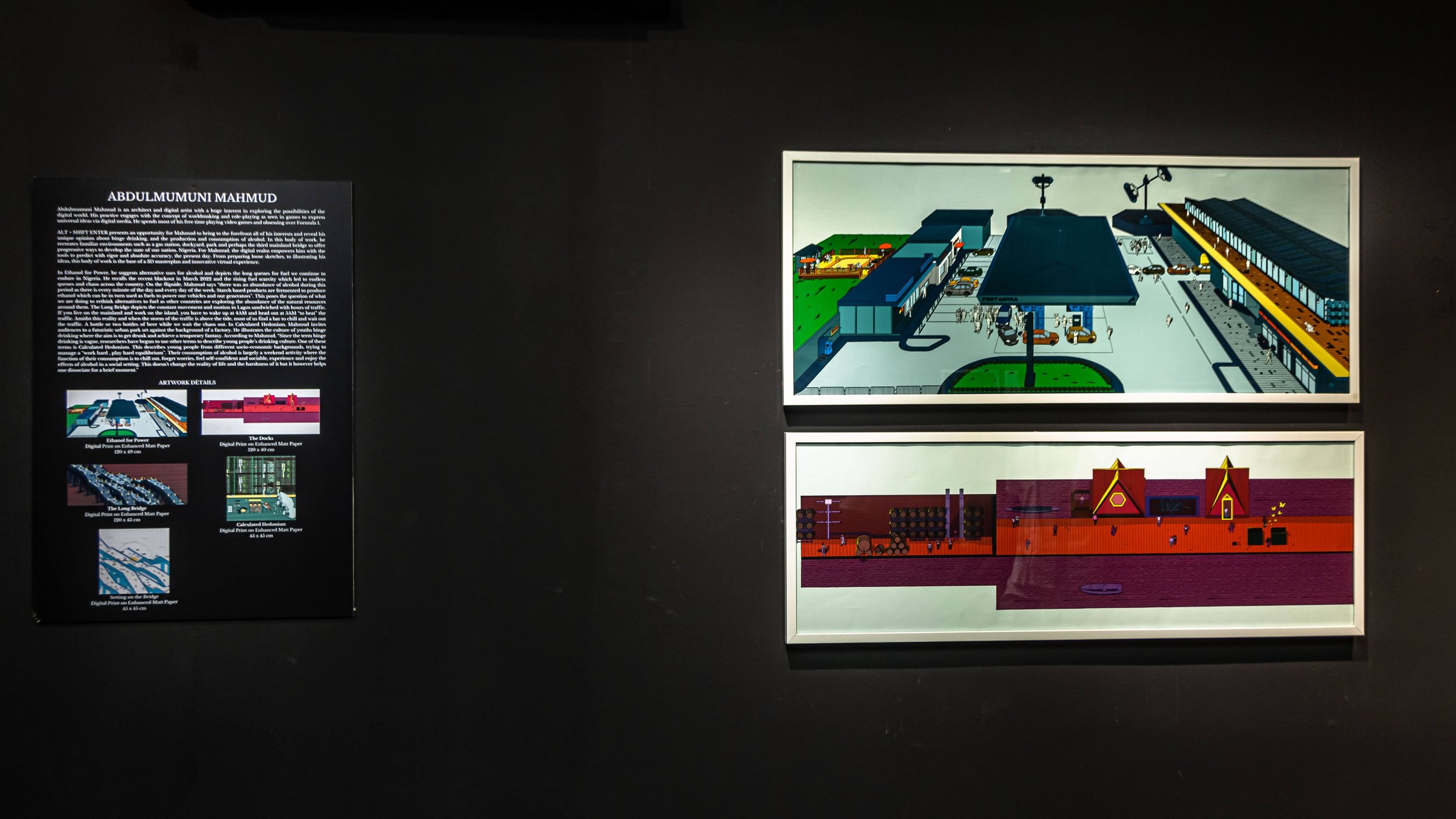ALT + SHIFT ENTER


















Art Bridge Project is pleased to present ALT + SHIFT ENTER, a multisensory experience and social experiment featuring Abdulmumuni Mahmud, Ifedoyin Shotunde, Tolu Ami-williams and Tosin Oyebisi.
ALT + SHIFT ENTER fuses experiential and material poetics with commentary on social, cultural, and political history as a way to encourage experimentation, reimagine identities and activate liberation. The starting point of the exhibition began with considering ways to shift the mindset of a new generation despite the confines of our present reality where there is a waging war, not too far from many of us, most especially in Nigeria.
Can you imagine a world where skin color, hair texture, national origin, and ethnicity are not determinants of power, class, beauty, or access? What does this world look like? What does it feel like? If you can see it, how do you know when you’ve achieved it? Some don’t want to imagine it; others are highly invested in the impossibility of it all. Unless we see a radical transformation, our motherland—Nigeria as we know it, will likely be recalled as a missed opportunity that became a tool for state-sponsored banditry, inequality, tribalism, political issues and corruption.
Exploring the intersection of desire, hope, and imagination, the exhibition uses alcohol as a case study to examine the notion of escapism, consumer culture and social inequality. Combining computer-based works, installations, performance and sound art, audiences are invited to reflect on futuristic ways to reconstruct society, and how it is manifested through the acceptance of a national identity that transcends individual differences.
Abdulmumuni Mahmud draws on the ideas of worldmaking and afro-surrealist storymaking to create a parallel reality where the very nature of life on earth is like a toy. Mahmud reverses overconsumption theories of alcohol and recognises toxic positivity, pain, trauma, fear, rage and ambivalence as inevitable forces shaping our everyday lives and consumption of alcohol. Here, alcohol is an attempt to grapple squarely with our unavoidable realities, emotions and vulnerability. Simultaneously, alcohol triumphantly connects us together. “The interest of this project lies in exploring the role of alcohol in our current society and how the Nigerian society can find alternate uses for alcohol in order to make this already profitable industry, of more tangible use to our current society rather than the current state of just the intangible uses”, says Mahmud.
With an eye for both the humorous and political, Ifedoyin Shotunde mediates and mirrors the strangeness of what’s happening in the world today. The artist investigates the crude nature of alcohol, and alcohol as a preservative and as a means of social security. Shotunde presents eerie and familiar installations that demonstrate his interest in materiality—locally procured and everyday materials. He plays with the concept of illusion by creating an installation with cow eyes in a jar filled with ethanol as its preservative. Also, by observing the post-consumption phase of alcohol, he builds a security wall fence as seen in several streets across Lagos and Nigeria made out of sandcrete blocks with broken bottles on top, instead of barbed or electric wires. Furthermore, he recreates a local liquor store that typically caters to the needs of lower-class citizens. His installations resonate with the works of Marina Abramović and Richard Serra whose artistic practice provides a bridge between ordinary experience and concepts that transcend the seemingly static nature of an artwork’s physicality. Ultimately, Shotunde’s reformist installation pushes audiences to question their role in the various forms of inequality in today’s world, and the gap between the upper class and the middle class.
Tolulope Ami-williams and Tosin Oyebisi echo the desire to be more, to be free of societal trends and patterns. Ami-williams stages an interactive performance art titled Je Ka Sa Lo, a Yoruba phrase which loosely translates to let’s escape or let’s run away. The performance addresses movement and distance as it relates to how individuals lose a sense of history and identity. If you change your position, your perspective changes and your narrative suddenly takes on an infinite number of new chapters. The performance sees Ami-williams pounding charcoal into a powder form contrary to the popular process of burning it into ashes, and mixing alcoholic drinks. In doing so, she embodies a journey of escapism where the subject retains its original qualities and takes on a new identity. Her performance captures “how the vehicles for escapism carry subjects through a journey that causes them to either lose touch or get a better grip on their interactions with what they consider to be reality.”
Close your eyes for a moment and listen to the space you are in! Tosin Oyebisi recreates a sonic bar environment with a soundscape titled Ògùrò that blends field recordings from his trip across West Africa, his visit to different bars in Lagos, a call to prayer, football commentary, conversations, busy road noise, bottles clinking and ambient sound. These are sounds of his daily life embedded with themes of communal love, brotherhood, identity and resilience. The vivid mental sonic imagery further delves into the pain shared by Nigerians over the controversies, disenfranchisement and violence during the recent 2023 elections. Oyebisi illustrates how the human experience is highly sonic, and the power of sound to instill in people a sense of place and belonging. Close your eyes again. Imagine a space that is not unlike the one described above. Only now, listen to the traditional percussion amplified in Oyebisi’s soundscape. You hear the djembe drum, bata, dumma and the gong accompanied with amapiano vibes.
From Abdulmununi Mahmud’s mythical universe to Ifedoyin Shotunde’s poetic installations, Tolulope Ami-williams’ guide to escapism and Tosin Oyebisi’s soundscape, ALT + SHIFT ENTER is a call for social change by revealing the ways, and looking at how artists of this generation are talking about the future. How do we get people to think of themselves as creators of tomorrow’s story?
Curated by Tony Agbapuonwu
